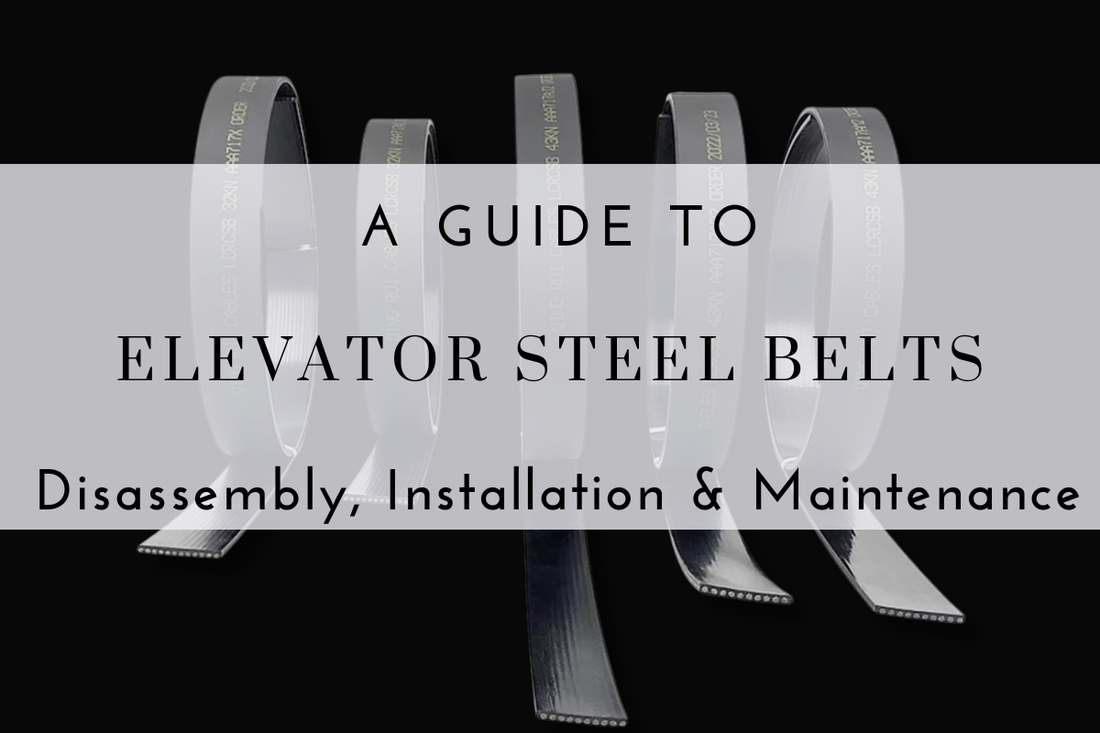Elevator traction steel belts are wear components that require proper handling and maintenance to ensure long-term safety and reliability. Their stable performance directly depends on scientific maintenance and correct installation procedures.
This guide summarizes five key aspects of steel belt management: unloading & storage, pre-installation inspection, installation standards, running-in adjustment, and routine maintenance.
If you’re looking for high-quality elevator steel belts that meet CE/ISO standards, you can Shop Now → at Echo Elevador Partes.
1. Unloading and Storage
Careful handling is essential when unloading elevator traction steel belts to prevent accidents or belt damage.
-
Avoid dropping or impacts: Do not drop the steel belt rolls or allow them to collide with metal forklift parts or other hard objects that may cause deformation.
-
Store properly: Keep belts in a cool, dry indoor environment, off the ground, and away from chemicals, gases, vapors, or any corrosive substances.
-
Outdoor storage precautions: If outdoor storage is unavoidable, cover the rolls with moisture-proof material to prevent rusting.
-
Periodic inspection: Regularly check stored belts for signs of surface corrosion or degradation. When necessary, apply anti-corrosion or lubricating agents compatible with the original manufacturer’s coating.
2. Preparation Before Installation
Before installing a new steel belt, verify that the product and its certification match the specifications and order requirements.
-
Check specifications: The minimum breaking strength must meet or exceed the elevator manufacturer’s requirements.
-
Record measurements: Measure and record the diameter of the new belt’s straight segment (dm) without tension.
-
Inspect for corrosion: If the belt has been stored for a long period, perform a visual and non-destructive inspection (e.g., MRT).
-
Verify pulley and groove condition: Ensure that all traction sheaves and guide pulleys are within size tolerance, free from wave-shaped wear, and have adequate remaining groove depth to safely support the belt.
-
Groove diameter: The groove diameter should be 5–10% larger than the nominal belt diameter. For optimal performance, at least 1% larger than the actual new belt diameter is recommended.

3. Installation Guidelines
Strict adherence to installation procedures is essential. Improper handling can cause twists, overlaps, or loops in the belt, leading to serious deformation and even scrapping.
-
Maintain straight alignment: Keep the belt straight while releasing it, minimizing slack.
-
Use a rotating reel: Place the belt roll on a turntable to release directly; for shorter belts, roll them smoothly along the ground.

-
Avoid throwing or rolling coils: Never release belts by tossing or rolling flat coils across the floor.

-
Control entry angle: Position the reel and its stand as far from the elevator machine as possible to minimize twist caused by entry angles.

-
Protect from contamination: Lay a protective mat (e.g., an old conveyor belt) under the released belt to prevent sand or debris contamination.
-
Control reel speed: Apply braking to large reels to control release speed; smaller reels generally require only single braking.

-
Maintain bend direction: Keep a consistent bending direction throughout installation — either top-to-top (from reel top to machine sheave top) or bottom-to-bottom (from reel bottom to machine sheave bottom).

-
Follow manufacturer’s instructions: Secure the belt ends according to the elevator manufacturer’s specifications.
-
Prevent friction: During installation, ensure the belt does not rub against any elevator components.
💡 Need help choosing the right size or type of steel belt for your project?
Contact our team or request a quote here →
4. Running-In and Adjustment
Before putting the new belt into full service, confirm that all travel limit and indicator systems function properly.
To allow the belt to adapt to operating conditions, conduct several test runs at low speed and low load (around 10% of rated load). This running-in phase helps distribute tension evenly and extends the belt’s service life.
5. Routine Maintenance
A maintenance plan should be designed based on elevator type, frequency of use, environmental conditions, and steel belt model.
-
Regular inspection: Professional personnel should regularly examine belts along traction sheaves, reels, and compensation chain zones.
-
Prevent drying or corrosion: Apply maintenance lubricant before signs of dryness or corrosion appear. Clean the belt surface if necessary before applying the agent.
-
Use compatible lubricants: Only use maintenance agents compatible with the original manufacturer’s lubricant and featuring good penetration properties. When in doubt, consult the belt supplier or manufacturer.
-
Shorten inspection intervals in harsh environments: Corrosive or high-moisture environments require more frequent checks.
-
Repair option: If broken wires are found only near the ends while the rest remains intact, shortening the belt and reinstalling the end fittings may be possible. Ensure the remaining length still meets the minimum wrap requirement at the reel in the elevator’s extreme position.

Final Thoughts
Proper handling, installation, and maintenance of elevator traction steel belts are essential to ensure safe and reliable elevator operation. Following these best practices will not only extend the service life of the steel belt but also significantly reduce maintenance downtime and operational risks.
Explore our full range of Elevator Traction Steel Belts → and Modernization Parts → to find the best solutions for your next project.


